The Amatuer Mycologist #27 - Pluteus cervinus - "The Deer Mushroom"
These posts are not for foraging. They are intended for entertainment and intellectual satisfaction only. These posts are not a field guide nor comprehensive in any way - their accuracy is not assured in any way. Do not eat wild mushrooms unless you are a professional, have substantial professional assistance or have a wealth of personal experience with a specific species. Do not make any foraging decisions based on these posts. To do so could be dangerous or life threatening.
These Posts Contains No Information Regarding Edibility Or Toxicity
Edit: My apologies - I somehow posted this without the citations - I must have copied and pasted incorrectly from my draft - they have now been added.
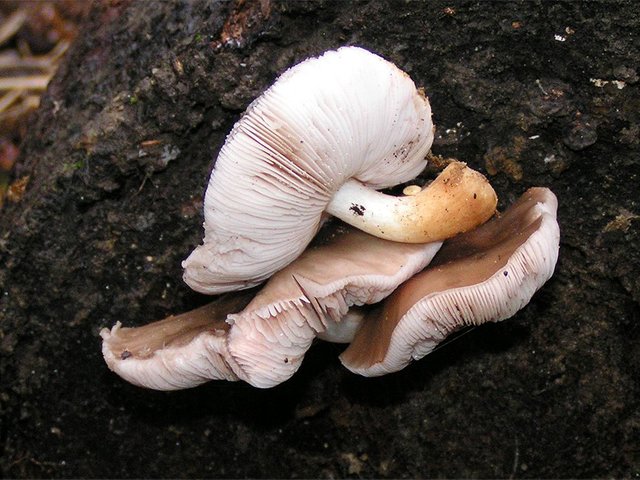
Don't let their plainness fool you - Pluteus cervinus has a lot going on under the hood
Sometimes you stumble upon a mushroom that just screams at you from the ground. Certain earthstars, for instance, could easily be mistaken for extra terrestrial lifeforms, while photogenic polypores can stick out like peacocks in contrast to the 'drag forest floor.
But now and again you will just find a plain mushroom that has no apparent uniqueness whatsoever. On it's face, Pluteus cervinus is totally that mushroom.
It's got an unremarkable cap, that varies onlywithin a range of brown earthtones, and when young, mostly white or whitish gills. The stem is mostly white, with just a little brown here and there nearer the bottom sometimes. The flesh is white. The whole thing appears wholly uninteresting.
But if you dive just little deeper, or even a lot deeper, P.cervinus turns out to be downright weird, in a good way.
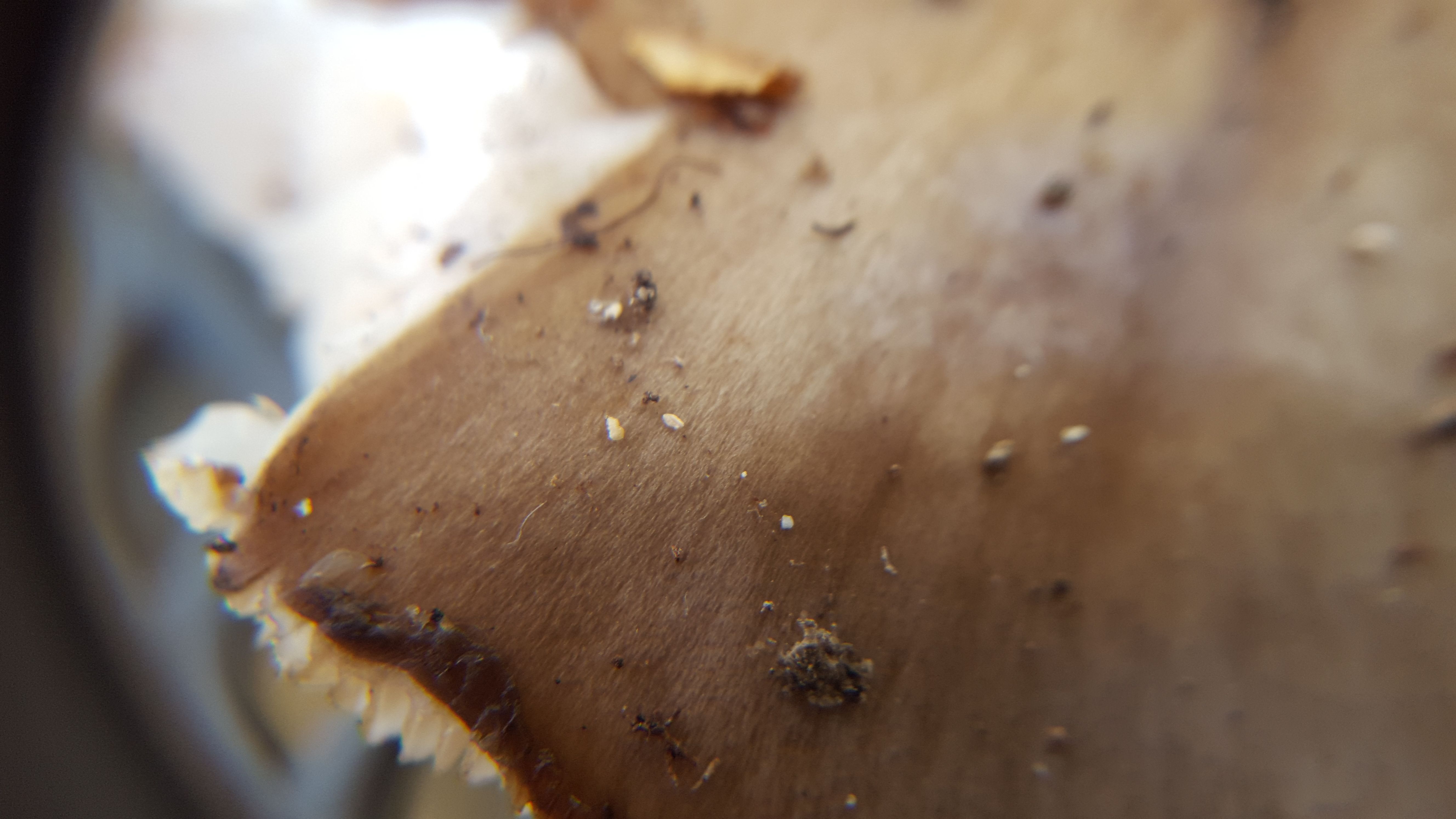
First, before we shrug off the mushrooms basic appearance, let's take a closer look.
The cap is not a show stopper, but it does have the sligtly fibers or hairs here and there on its surface, along with a small amount of deteitus indicating it might once have been sticky. The color takes on a little more depth up close, but this one is really pretty plain brown overall.
The young mushroom starts convex, but it eventually flattens out - eventually even upturning the gills around the edges as they get older.
I accidentally deleted the pictures of the fresh mushroom with its whitish colored gills - but a subtle color change happens when the spores begin to be released.
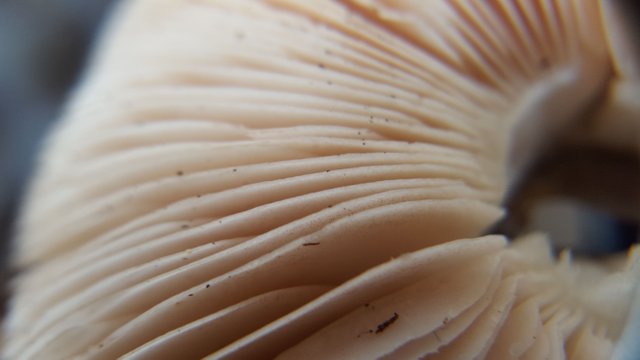
The gills take on a pinkish tone, and up close, bear the hint of ejected spore material.
It is at this point that the gills become uoturned around the edges, or at least the specimen I found did.
One other important macroscopic feature for this mushroom is that The gills are not attached to the stem.
I lost the photo that showed the unattached gills near the stem - but this macro video displays the gap remaining after the stem was easily removed, without causing damage to the gills.
That about does it for the macroscopic identifiers. What will a spore print reveal.
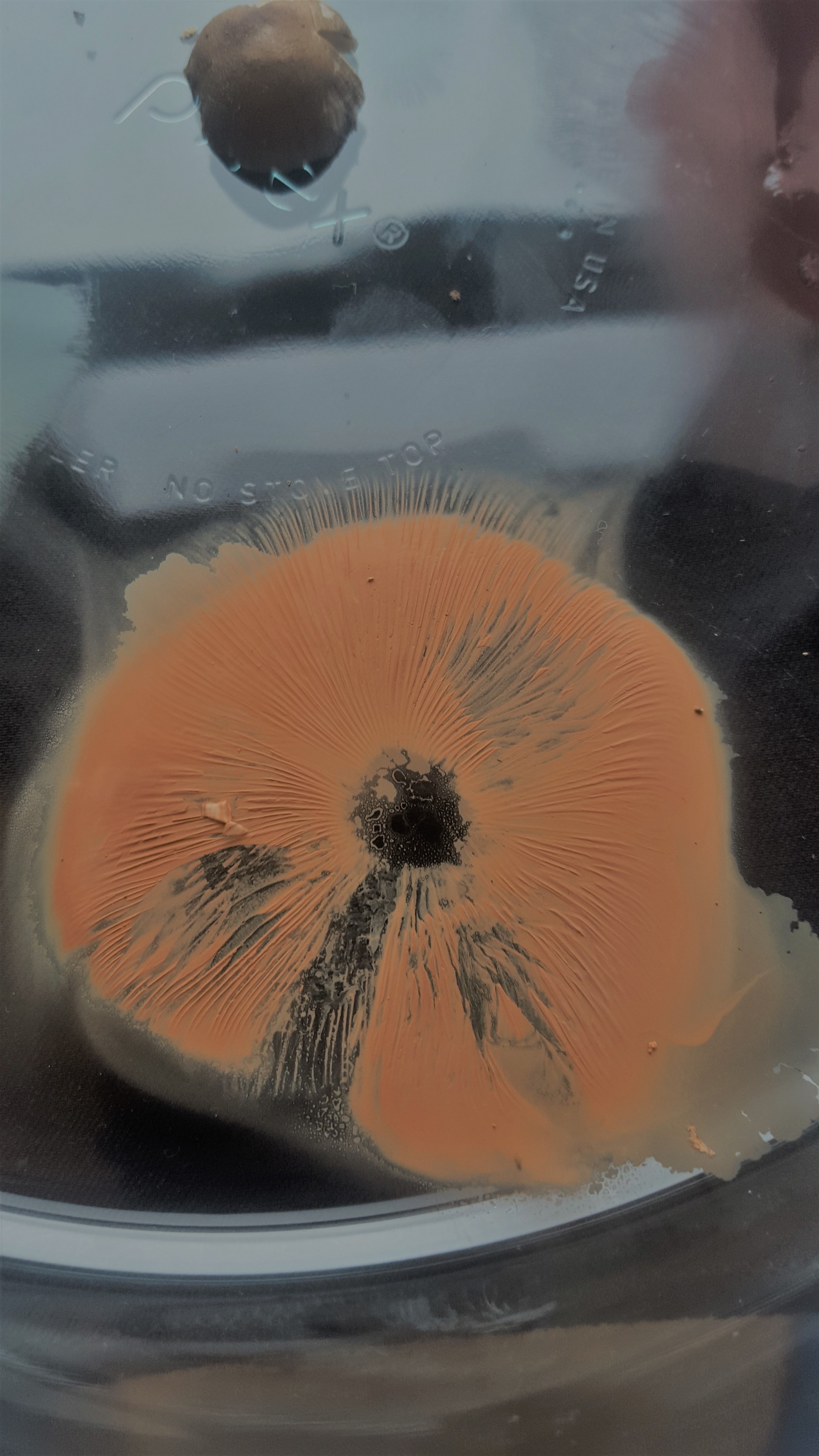
A pinkish, brownish, orangish (dark salmon?) color that seems to have no relation whatsoever to the mushroom it came from.
The spore print is the first nice surprise. I've applied a slight filter on this picture to try to get a better sense of the true color - the photo made it more pure orange-brown when in reality it had some pink in it.
If you had no access to microscopic equipment, you could probably rely on the traits we've covered so far to get a bead on P.cervinus.
However, the real distinguishing weirdness is happening microscopically!
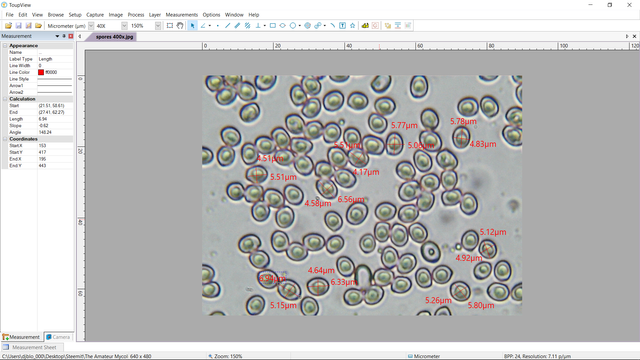
First, here are the spores with measurements.
As I've found already in my brief time measuring spores, the average size ranges tend to vary from specimen to specimen, as well as from source to source. In this case the bottom end of the spore size range falls outside Kuo's estimated range, but falls squarely within the range of two other cited sources.
The general shape of the spores abides all sources however, and there are no totally abnormal deviations in size - so far so good.
But it was not the spores that drew my attention under the microscope - but these...uh...other things...
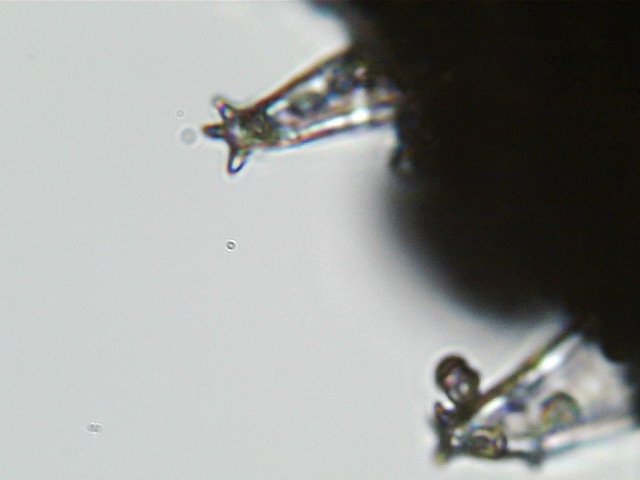
What the heck is that thing?
At first I thought it was a basidia with three sterigmata to disperse mature spores. Except I never found one that was loaded, and the scale relative to other structures seemed way off.
But the damned things were everywhere
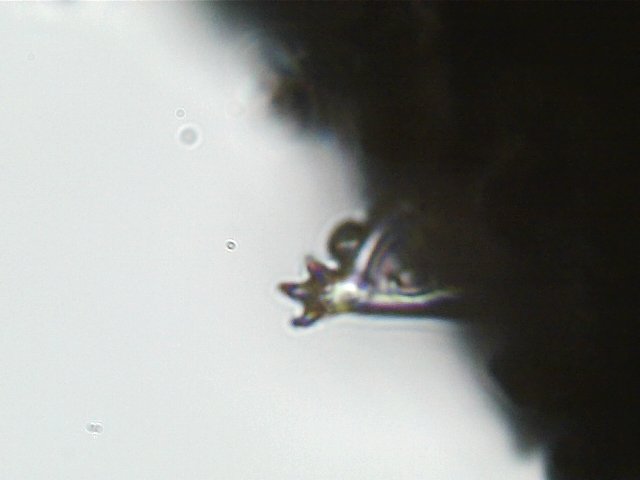
Every other move of the slide revealed another three pronged tower rearing its head.
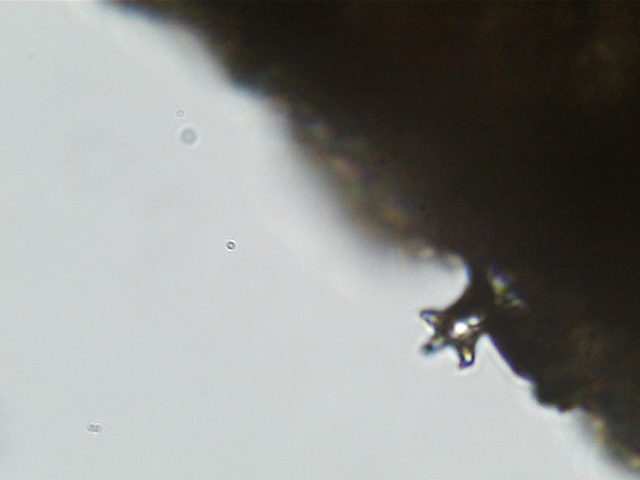
Without any idea what they were, I saved the photos and made a mental note of the structure.
A day passed and I began to run my analysis through some keys and eventually came to Pluteus cervinus by means of the macroscopic traits and spore print. I was sort of sure, but not 100% until, in almost every source, I saw the same three horned microscopic tower I'd identified under the microscope!
It turns out these horned towers, called Cheilocystidia - apparently sterile cell growths protruding from the gills - are the definibg microscopic trait for this species! It is the horns or "antlers" on these microscopic towers from which the species derives its names, cervinus - cervus is latin for deer - or the "Deer Mushroom".
Most exciting of all is that I found this structure without knowing what to look for! It may seem a small thing, but that is a major diagnostic milestone!
Finally, for thoroughness sake, here is a photo of what I believe is a full three pronged basidia, which is much smaller than the antlered towers.
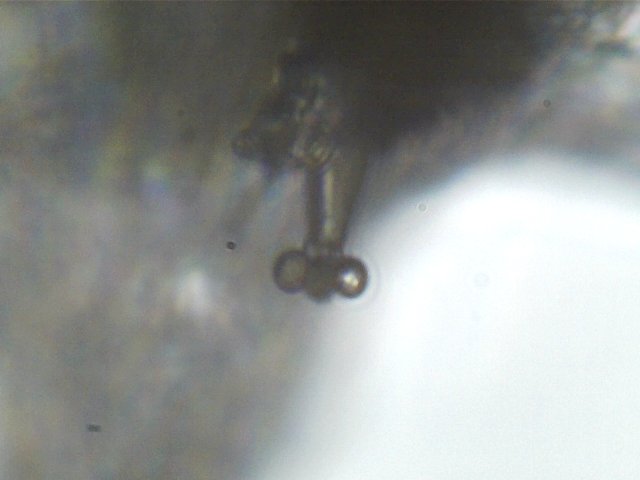
I only found one structure that looked like this.
Although it seems to fit the bill for the basidia, in truth I don't know that it is. This is where the limitations of my skill and lack and tools reveal themselves. The only reason the Cheilocystidia were as forthcoming is because of their abnormal size. In order to capture the basidia with regularity, I will need to get better at proper mounting and, eventually, buy some stain.
For now, I'm just reveling in another major practical advancement. This was a case where I found an unidentified mushroom, microscopically analyzed it without any knowledge of what to look for, and then made observations which turned out to be dispositive in the mushroom's identification. That means, imperfections aside, my microscopy works, and I couldn't be happier.
MACROSCOPIC CHARACTERISTICS
Cap = In this case shades of brown with some subtle streaking in the surface - covered in a few small fibers here and there - multiple sources indicate it begins convex before flattening out. Mine was already flat when found and then became slightly upturned around the edges, with the gills more fanned out, after being left for a spore print. Detritus stuck to the cap indicates it was once sticky, but it was dry to the touch when I found it. Size ranges from 4 to 10 cms, with mine in the middle around 5cm. Kuo indicates a slightly wider variation of color is also possible, but mostpictures depict shades of brown.
Spore surface = Gilled, white or whitish when young - free from the stem - then as the spores begin to be released turning light pink. May get even darker with time to flesh color, but I did not see that.
Flesh = white, not bruising or changing color when damaged.
Stem ("stipe") = Mostly white, with some brown coloration or fibers on it - sometimes small hints of spores collecting on it as well. Not hollow and roughly even. Some indications it can grow down right long - 13cm? - but mine was fairly diminutive at 4 to 5 cm long and curved up from the side of a log.
Spore Print = Others estimate a color from pink to dark pink - I'm going to say orangish brown with a distinctintly pinkish overtone. I'm beginning to see how the descriptive rabbit hole gets dug.
Ecology ("How it grows.") = Saprobic, on hardwoods - possobly also on conifers but less normal. Never terrestrial nor on woodchips, which might indicate a technically distinct species. Spring into at least fall - but I found this on a wintery November morning this year.
Distribution = Definite common on the East Coast of the US, but also seems reported from thw west coast as well.
KOH reactivity = I saw no reaction on cap - spores browning in KOH
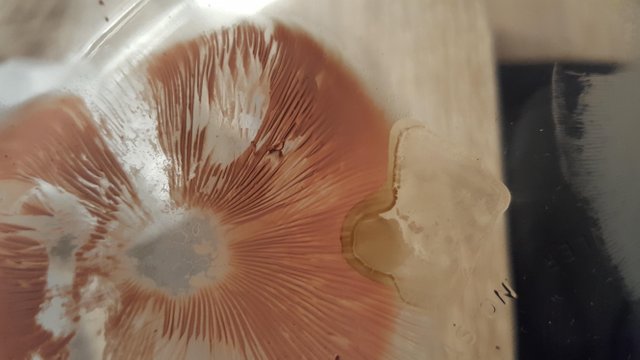
Spores = Ellipsoid, or like a slightly smooshed circle. Mine went from 4-6microns x 5-7 microns
Other = Derives its name and nickname from the three horned Cheilocystidia which pop up all over the gills microscopically. There may be a wider and deeper variation of species than originally thought - check out Kuo's site for details.
THIS POST IS NOT INTENDED FOR FORAGING PURPOSES AND TO USE IT FOR THOSE PURPOSES WOULD BE DANGEROUS. DO NOT HUNT WILD MUSHROOMS WITHOUT RELYING ON A COMBINATION OF PROFESSIONAL FIELD GUIDES, IN PERSON PROFESSIONAL GUIDANCE, OR IN PERSON GUIDANCE BY SOMEONE TRUSTWORTHY WHO HAS COPIOUS LOCAL, SPECIALIZED MUSHROOM HUNTING EXPERIENCE. FAILURE TO DO SO CAN RESULT IN GRIEVOUS PERSONAL HARM OR DEATH.
Photos Are My Own - Except:
[Photo 1 - I accidentally deleted the photo of the mushroom I found in the wild - mine was alone, but in the same growing position and with same colors as this photo]photo taken by Eric Steinert at Freising, Germany Cc-by-sa-2.5,2.0,1.0 via Wikimedia commons
Microscopic photos were taken using an AMScope M150B entry level microscope. If you use microscopes, I'm quite sure you've never heard of this model - but its cheap and available on Amazon. The camera lens is also AMScope, MD35 - by far their crappiest microscope camera. But, as we will confirm on Thursday, still capable of material, relevant, and in some cases, dispositive, data collection. Lastly it should be noted that the precise magnifications are not easily deduced using the camera - but based on relative spore sizes compared to known microscopic photos from Kuo and other sources, I estimate 40, 100 and 400x.
Information Sources
[1]Kuo, M. (2015, June). Pluteus cervinus. Retrieved from the MushroomExpert.Com
[2]Mykoweb's Michael Wood and Fred Stevens on P.cervinus
[3]Tom Volk on P.cervinus
[4]Gary Emberger, Messiah College on P.cervinus
[5]Wikipedia on P.cervinus
[6]First Nature on P.cervinus
It's interesting that it grows in the warmer months. I live Jerusalem and I have never seen any kind of mushroom period (That doesn't mean they are not around). I am not clear on the the purpose of the Basadia on this particular species. Why does it even exist.
Well the basidia are the spore dispersing structures. If you mean the cistidia with the three horns, no one else is really sure what they do either!
Sorry, I meant the Cistidia as shown in the microscope. That looks spooky to me sure.
always great to see your posts. I'm learning all the time, love how mushrooms can seem so ordinary but yet are so vital to our ecosystem and have such an amazing network of communication going on.
Thanks again for your attention to detail, especially loving the Cheilocystidia, that is pretty awesome.
Keep up the great work and as always thanks for sharing your passion with us.
I think you if you keep up this blog your going to need to change it from amatuer mycologist to professional mycologist. I always enjoy your posts. Keep up the good work!
Much appreciated! There is an ephemeral barrier between amateur and professional after a certain amount of time and experience I guess, but trust me when I tell you I am to the professional mycologist what a toddler in teeball is to a professional baseball player. :)
Well actually your getting paid on your article about mycology so you at lease a part time professional ;)
I never knew anything about mushrooms before reading this. Very interesting post-- and educational! The Deer Mushroom... so cool. Do you do this sort of thing for a living? What sort of stuff do you do? Apologies, but I'm honestly quite hopeless when it comes to science though it's super interesting to me!
Just a hobby of mine - but I've only just scratched the surface of it all. Luckily mushrooms are ubiquitous and online resources are available so it's an easy hobby to start
You thoroughly examined that fungus. I have a feeling eventually you'll uncover something that the mycologists have missed.
I appreciate the complement - but believe me, the surface has barely been scratched and a great mamy others have dug deeper than you can imagine :)
Thank you for be our educational mushroom world that are very extrange world for the normal humans, the people who know about mushroom is a great person which have an extrange pasion and knowledge.
Thank you again for teaching us.
Best regard.
@galberto
That's very kind of you to say - I'm just glad this learning process is of interest to anyone :)
Thanks for sharing these macro shots, and this very informative write-up! Mushrooms and fungi are one of my favourite things to shoot as well.
Today I was just listening to an episode of Joe Rogan Experience with Paul Stamets!
Congratulations @dber! You have completed some achievement on Steemit and have been rewarded with new badge(s) :
Click on any badge to view your own Board of Honor on SteemitBoard.
For more information about SteemitBoard, click here
If you no longer want to receive notifications, reply to this comment with the word
STOPThis post has received gratitude of 4.95 % from @appreciator thanks to: @dber.
This post was promoted with @monitorcap traffic bot & STEEM promotion service.
Send MIN. $1 SBD to @monitorcap bot with your link in MEMO field
and recieve upvotes & resteems for your posts. @monitorcap - where 'seen' matters !